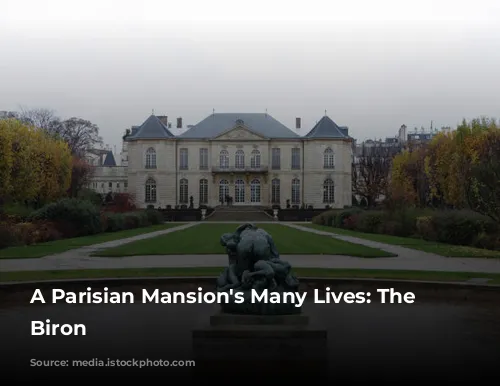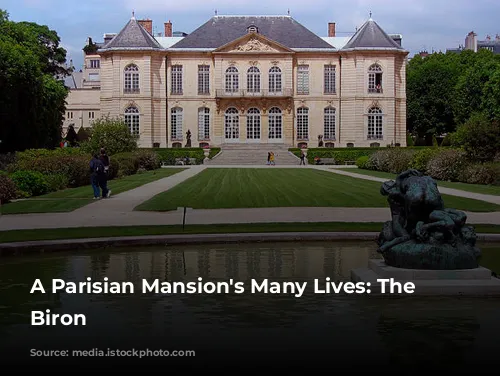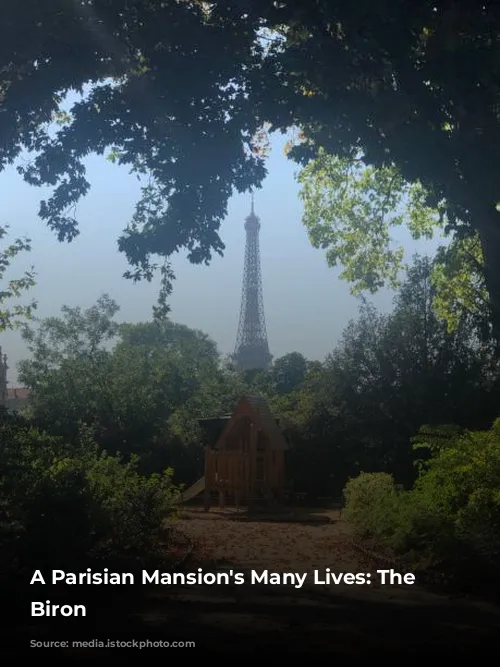The Hôtel Biron, a grand mansion on Rue de Varenne in Paris, has seen centuries of change, passing through the hands of various owners and tenants, each leaving their mark on the building and its surrounding gardens. Let’s journey through time to discover the fascinating history of this iconic property.

From Noble Residence to Duchess’s Retreat
In 1736, the mansion was leased to the Duchess of Maine, who made subtle changes to the interior while preserving the building’s stately exterior. Upon the duchess’s passing in 1753, the property was acquired by Louis-Antoine de Gontaut-Biron, the future Marshal Biron. He transformed the gardens into a masterpiece, a blend of French formality and English whimsy. He expanded the ornamental garden, created a circular pond, and even added a section with an English garden aesthetic. While respecting the original design and plantings, Biron’s enhancements made the gardens one of the most celebrated in Paris. He also preserved the kitchen garden, relocating it within the estate. The gardens of this period are well documented, thanks to detailed descriptions and engravings published between 1776 and 1778. Marshal Biron left his mark on the mansion, bestowing upon it the name by which it is known to this day: the Hôtel Biron.
A Stage for Celebration and Diplomacy
After Marshal Biron’s death, the mansion and its grounds saw a flurry of activity. In 1795, the Duke of Charost transformed the kitchen garden into an English garden, adding a charming stretch of water. He also rented the entire estate for a year, transforming it into a festive haven. The public was invited to participate in country-style festivities, enjoying games, dances, concerts, and spectacular fireworks displays. The mansion itself became a venue for diplomatic affairs. In 1806-10, the Holy See leased the building, housing Cardinal Caprara, one of the papal legates. And in 1810-11, the Emperor of Russia relocated his embassy to the Hôtel Biron.

From Boarding School to Artists’ Haven
In 1820, the Duchess of Charost sold the estate to a trio of nuns, including Reverend Mother Madeleine-Louise-Sophie Barat, founder of the Society of the Sacred Heart of Jesus. The nuns established a boarding school for girls and made significant alterations to the buildings and grounds to accommodate their educational mission. The original decorations gradually vanished, replaced by more practical elements, with the opulent wood paneling, wrought-iron work, and painted designs being sold to wealthy collectors to fund the renovations. Marshal Biron’s pool was filled in to create a mound for an ex-voto dedicated to the Virgin. The garden was eventually repurposed for practical needs, becoming a kitchen garden, orchard, and pastureland.

A Legacy of Art and Inspiration
In 1904, the Society of the Sacred Heart was dissolved, and the Hôtel Biron was placed in the hands of a receiver, awaiting a buyer. The mansion became a haven for artists during this period. Among the tenants who occupied the Hôtel Biron were Jean Cocteau, Henri Matisse, Isadora Duncan, and Clara Westhoff, who later married Rainer Maria Rilke. It was Rilke who introduced the renowned sculptor Auguste Rodin to the property. In 1908, Rodin rented four rooms on the ground floor with terraces facing south, using them as studios. The untamed garden, a contrast to the formal gardens of the past, left a deep impression on Rodin, inspiring him to place his sculptures and antique collection amidst the greenery. By 1911, he had taken over the entire mansion, making it his home and studio.

Conclusion
The Hôtel Biron has witnessed a remarkable transformation, morphing from a grand noble residence to a duchess’s retreat, a venue for festivities and diplomacy, and a boarding school for girls. But it is perhaps best remembered for its time as an artists’ haven, where Rodin, inspired by its historical grandeur and wild garden, found a perfect space to create and showcase his masterpieces. The Hôtel Biron stands as a testament to the enduring power of art and the ever-changing nature of Parisian life.
